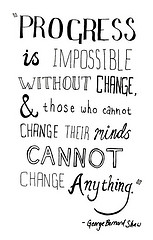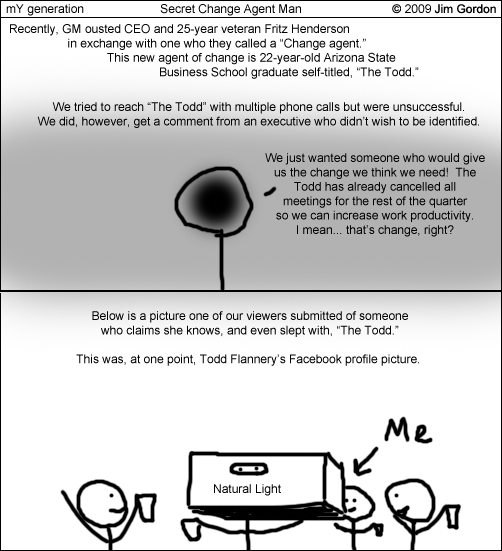|
|
|
Monday, April 21st, 2014
 I get it. I get what’s going on in terms of women in the workplace is news. I get it. I get what’s going on in terms of women in the workplace is news.
I get it that it is important to remind people that for all the progress that’s been made some things haven’t changed.
It’s still assumed that it’s OK to ask professional women, such as lawyers and marketing execs, to do stuff that would never be asked of the men in the organization.
“…plan parties, order food, take notes in meetings and join thankless committees…bring cupcakes for a colleague’s birthday, order sandwiches for office lunches and answer phones”
By the same token, it’s news that board diversity is moving at glacial speed, primarily because boards only want people with experience and to have experience they need to serve on a board.
“Recruiting women and minorities to boards is being slowed because of boards’ unwillingness to look at candidates who have not yet served on boards,” said Ron Lumbra, co-leader of the CEO and board services practice for Russell Reynolds. “There’s a premium on experience.’’
So while I have no problem with these subjects being presented over and over in the news, there is one thing I don’t understand.
Why are so many people surprised by the information?
Is the general population so naïve that they actually believe women are no longer asked to do tasks that are closer to house work than business work?
Do they really believe that the lack of board diversity is a function of the lack of experience as opposed a desire to spend time with people like themselves who are well within their comfort zones?
The sad part is that while it’s still news, it’s certainly not a surprise.
Flickr image credit: Arya Ziai
Posted in Change | No Comments »
Wednesday, February 26th, 2014

Cut through all the noise about how fast the world is changing, how to stay competitive, constant learning, retraining, etc. and one message comes through loud and clear.
Whatever the entity or organization he/she/it needs to know how to transform in order to stay relevant.
Transformation is a must whether you’re a bookstore or an author who believes there’s a need for them.
A men’s retailer, a woman’s or the mannequin supplier dealing with human non-uniformity.
Or a record store.
Not just relevant, but happy.
A person growing or a person doing a 180 pivot.
Whether entity or organization transformation is accomplished by changing MAP (mindset, attitude philosophy™).
But transformation itself starts by choosing to do it.
Flickr image credit: DaveHuth
Posted in Change, Personal Growth | No Comments »
Tuesday, December 17th, 2013

It’s almost 2014; a clean slate to do great stuff—but is it really?
Four years ago I identified one reason that change is so difficult, especially when it comes to tweaking/changing culture.
That reason is still with us and is just as much of a problem now as it was then, which means my post is as valid now as it was in 2009.
So, in the interests of a great 2014, here is a little bit of guidance on moving those changes along.
Ducks in a Row: Eliminating Cultural Stuff
I read a fascinating article today about Americans, their stuff and their penchant for storing it instead of getting rid of it.
“The US has 2.3 billion square feet of self-storage space. (The Self Storage Association notes that, with more than seven square feet for every man, woman and child, it’s now “physically possible that every American could stand — all at the same time — under the total canopy of self-storage roofing. …one out of every 10 households in the country rents a unit…”
According to Derek Naylor, president of the consultant group Storage Marketing Solutions, “Human laziness has always been a big friend of self-storage operators, because once they’re in, nobody likes to spend all day moving their stuff out of storage. As long as they can afford it, and feel psychologically that they can afford it, they’ll leave that stuff in there forever.”
I’ve said for years that people aren’t water faucets, able to turn off emotions and thoughts or change their MAP just because they change environments from home to work or vice versa.
Reading the article made me realize a hidden reason that makes changing culture so difficult.
It’s not just that the parts of the culture changes, but that the employees won’t let go of the parts that are changing or being replaced; instead they store them away to sort later.
But later never comes, so, like the stuff in the storage units, it sits in the back of their minds running up a bill that is paid in energy, focus and productivity.
As a result of the economy, many of the thousands of storage units that were in use for no other reason than laziness are being cleared out, or at least downsized, and the stuff gotten rid of.
Perhaps this is a good time to work with your employees to clean out their mental storage places; to purge the cultural residue and clutter that fills them up.
So clear out the rubbish, open the windows and let the fresh air flow through reenergizing everyone.
I’m not saying that change is easy, but I hope this bit of insight will help you fulfill your 2014 vision.
Flickr image credit: Guy Renard
Posted in Change, Culture, Ducks In A Row | No Comments »
Tuesday, November 19th, 2013

Everyone has an opinion on Snapchat turning down a $3 billion offer from Facebook (here’s the thinking of others who have been there), but the comments that caught my eye were from Gary Burnison, Korn/Ferry’s CEO, who focused on the cultural aspect.
Burnison said that based on his company’s experience, “…people are hired for what they know, they are fired for who they are.”
Very true, but it shouldn’t come as a surprise, as I said five years ago when I wrote Culture Trumps whether Hiring or Acquiring.
The problem is that managers often ignore culture, because they believe they that theirs is ‘right’ and the other will change. It’s not a case of you/your company being right and ‘her/them’ being wrong, it’s a case of the pieces don’t fit—and 98% of the time you should see it coming.
The power of culture has been at the forefront of many discussions, with top CEOs focusing on culture above everything, including strategy. When his investors wanted to cash out, Tony Hsieh knew going public would destroy the culture, so he sold Zappos to Amazon instead.
Burnison also said, “I never thought I would see culture trump money with $3 billion on the table.”
I did, but I thought it would take a lot longer before a CEO, let alone a founder, had the insight to understand that a successful culture is priceless.
Flickr image credit: Neil T
Posted in Culture, Ducks In A Row | No Comments »
Tuesday, September 24th, 2013

What could Larry Page’s Google possibly have in common with Steve Ballmer’s Microsoft?
Would you believe corporate culture?
Google, long held up an example of great culture is, in fact, as political and siloed as Microsoft.
Not only similar siloed cultures, but a similar approach to changing them.
Ballmer believes that a deeply entrenched culture can be changed by edict and apparently Page does, too.
Page laid down the law: “If you keep fighting, we’ll be very happy to send you to the competition.
“During the speech, one of the executives who was in the room turned to a friend and whispered:“Did he just say, ‘zero tolerance for fighting? I’ve been here for years. All we do is fight.”
If Page is serious about the ‘change or else’ approach you can count on seeing high turnover at Google.
But don’t hold your breath, because words don’t always mean what they say.
Words are interpretive, so people tend to assign their own meanings and put their own spin on what is said.
Says a source who heard the Larry Page sermon at the Carneros Inn: “What he meant by ‘zero tolerance for fighting’ is don’t go overboard.”
This source says there is a “healthy way” to fight at Google.
“The healthy way to fight is to wear two hats.”
“You’ve got to wear your YouTube or Android hat,” the source says. “But the mature executive at Google knows when to put on the Google hat.”
Politics and infighting can only exist if they are openly accepted or covertly tolerated.
As one longtime Google executive put it: “If the princes [are at] war, it’s because the king tolerates it.”
Who knew?
Flickr image credit: mshamma
Posted in Ducks In A Row | No Comments »
Tuesday, July 16th, 2013
 I’ve written many times about the importance of breaking down both horizontal and vertical silos (for more click the silo tag), but I don’t believe it can be done with an edict—even if that edict comes from Steve Ballmer. I’ve written many times about the importance of breaking down both horizontal and vertical silos (for more click the silo tag), but I don’t believe it can be done with an edict—even if that edict comes from Steve Ballmer.
This is especially true at a company like Microsoft, where the silos were intentionally built decades ago as part of the corporate structure.
Vertical silos, by nature, create, at the least, rivalry, but, more often, an “us against them” mentality within each silo.
For thousands of Microsofties, that’s the only cultural world they have known; many of them grew up in it, both in terms of years and promotions.
Changing culture is recognized as the most difficult organizational change any company, no matter the size, can undertake.
And one of the greatest error’s a CEO makes is thinking that all he needs on board is his senior staff the rest of people will fall in line.
For most companies, let alone one the size of Microsoft, terminating managers and workers that don’t fall in line isn’t even an option, since there is no way to replace them.
Yet having large numbers of your workforce on different cultural pages is a recipe for disaster.
The results of Ballmer’s changes will unfold over the next couple of years—in spite of Wall Street’s quarterly focus.
Changing culture is tremendously difficult; Charlie Brown didn’t pull it off at AT&T; Lou Gerstner said it was the most difficult part of turning around IBM.
Do you think Ballmer will succeed?
Flickr image credit: Tobyotter
Posted in Change, Culture, Ducks In A Row | 4 Comments »
Tuesday, January 22nd, 2013
 Ugly culture is culture that is fragmented and doesn’t work together. Ugly culture is culture that is fragmented and doesn’t work together.
According to top researchers this is a function of the different mindsets between operational, executive and engineering.
Three viewpoints equal three cultures (requires free registration).
And while I’m certainly not anything like the experts mentioned in the article I don’t believe it’s a given.
I also find the so-called typical mindset of each group to be more a function of the past than the current, let alone future, mindsets, especially of entrepreneurs and those ascending to executive ranks and the top slots of many companies.
Granted, the larger the company the more likely to find those attitudes, but it’s not a given.
The experts see three silos, operational, executive and engineering, completely ignoring multiple other vertical and horizontal silos.
Of course, the article is 11 years old, so the question is ‘does it still apply’?
Does your workplace reflect these three silos or is the current reality far more nuanced?
Flickr image credit: Sam Wolff
Posted in Culture, Ducks In A Row | No Comments »
Tuesday, June 12th, 2012
 A few years ago I wrote about the value of learning to insult with class, instead of crass. A few years ago I wrote about the value of learning to insult with class, instead of crass.
A few weeks ago I read a post that reminded me how much language reflects company culture.
But I found myself in the middle of a conversation about how a class of vendors would “rape” the company being discussed. There were 10 men in the room and me, and the word kept getting repeated, with intensity, from person to person as the discussion grew.
Penny Herscher, CEO of FirstRain, found herself “distressed and very uncomfortable.”
That reaction from a woman weaned on blue language and sexual harassment a la the semiconductor industry—not an environment conducive to shrinking violets or sensitivity—says volumes for the effect of language in the workplace.
Think about it.
Can you imagine Tony Hsieh, who created a culture that produced what is arguably the best customer service in the world and now teaches others how to replicate it, use violent language, whether raping a company or killing the competition, to get his point across?
Yet he succeeds admirably.
People with poor verbal communication skills often resort to four-letter words either from ignorance or laziness.
‘Rape’ and ‘kill’ are four-letter words.
Flickr image credit: Jonathan Assink
Posted in Communication, Culture, Ducks In A Row | 2 Comments »
Wednesday, May 23rd, 2012
 In our wired era being available 24/7 generates both bragging rights and work/life balance complaints and nowhere more so than the high-powered world of management consulting. In our wired era being available 24/7 generates both bragging rights and work/life balance complaints and nowhere more so than the high-powered world of management consulting.
It was in this world, as represented by a small team at Boston Consulting Group, that HBS professor Leslie A. Perlow initiated an experiment four years ago on the extreme benefits of “predictable time off” (PTO).
She shares the story and documents her findings in a new book called Sleeping With Your Smartphone.
Supposedly, the unpredictability working across time zones requires constant availability, but is that true?
“What caught our attention was that the more people were on, the more unpredictable their work time seemed to become.”
The key to success was predictability.
Perlow’s research started with a small team and three basic steps.
- “First, team members have to agree on a specific unit of time each week that everyone can turn off. Not at the same time, obviously, since team members have to cover for each other. In our first experiment, it was one night a week. But whatever the goal, it has to be valued by the team, as a group. It has to be small but doable. And it has to be concrete and measurable.”
- “Second, the team needs to meet weekly to discuss the challenges and successes they’re facing as they try to achieve the goal. These meetings are crucial for PTO to work, but they offer much more. They’re a regular forum for productive conversations about work, conversations that empower people to speak up. In theory, people are speaking up about process, which allows the team to meet the time-off goal. But really they’re speaking about all aspects of the work experience.”
- “Finally, the team’s leaders — bosses, managers — have to show support for the project and for team members’ efforts. That’s not just about allowing colleagues to speak up and to use their time off. It’s also about doing the same themselves.”
Four years later 86% of the consulting staff in Boston, New York, and Washington, DC are practicing PTO.
According to BCG’s CEO, Hans-Paul Bürkner, the process unleashed by these experiments “has proven not only to enhance work-life balance, making careers much more sustainable, but also to improve client value delivery, consultant development, business services team effectiveness, and overall case experience. It is becoming part of the culture—the future of BCG.”
Retention is up, job satisfaction is up, productivity is up, client satisfaction is up.
Given proven results and a reliable methodology to follow, PTO can be instituted by any manager at any level even where the over-arching culture is hostile.
Nor is there any need for HR approval.
Go ahead; reap all those rewards and be a hero to your team—all it takes is 20 bucks and synergistic MAP, both of which are in your direct control.
Image credit: Harvard Business School
Posted in Change, Culture | No Comments »
Sunday, December 4th, 2011
Another gem from the archives. See all mY generation posts here.

Posted in mY generation | No Comments »
|
 Subscribe to
Subscribe to
MAPping Company Success
About Miki 
Clarify your exec summary, website, etc.
Have a quick question or just want to chat? Feel free to write or call me at 360.335.8054
The 12 Ingredients of a Fillable Req
CheatSheet for InterviewERS
CheatSheet for InterviewEEs™
Give your mind a rest. Here are 4 quick ways to get rid of kinks, break a logjam or juice your creativity!
Creative mousing
Bubblewrap!
Animal innovation
Brain teaser
The latest disaster is here at home; donate to the East Coast recovery efforts now!
Text REDCROSS to 90999 to make a $10 donation or call 00.733.2767. $10 really really does make a difference and you'll never miss it.
And always donate what you can whenever you can
The following accept cash and in-kind donations: Doctors Without Borders, UNICEF, Red Cross, World Food Program, Save the Children
*/
?>About Miki
About KG
Clarify your exec summary, website, marketing collateral, etc.
Have a question or just want to chat @ no cost? Feel free to write
Download useful assistance now.
Entrepreneurs face difficulties that are hard for most people to imagine, let alone understand. You can find anonymous help and connections that do understand at 7 cups of tea.
Crises never end.
$10 really does make a difference and you’ll never miss it,
while $10 a month has exponential power.
Always donate what you can whenever you can.
The following accept cash and in-kind donations:
|
 I get it. I get what’s going on in terms of women in the workplace is news.
I get it. I get what’s going on in terms of women in the workplace is news.







 I’ve written many times about the importance of
I’ve written many times about the importance of  Ugly culture is culture that is fragmented and doesn’t work together.
Ugly culture is culture that is fragmented and doesn’t work together. A few years ago I wrote about the value of learning to
A few years ago I wrote about the value of learning to  In our wired era being available 24/7 generates both bragging rights and work/life balance complaints and nowhere more so than the high-powered world of management consulting.
In our wired era being available 24/7 generates both bragging rights and work/life balance complaints and nowhere more so than the high-powered world of management consulting.

